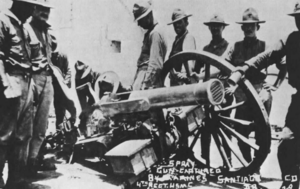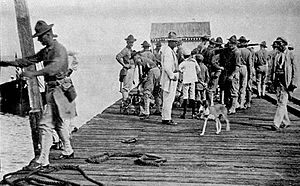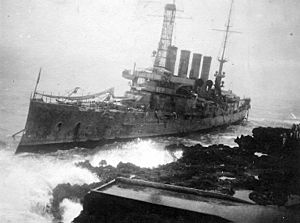United States occupation of the Dominican Republic (1916–1924) facts for kids
Quick facts for kids United States occupation of the Dominican Republic (1916–1924) |
|||||||
|---|---|---|---|---|---|---|---|
| Part of the Banana Wars | |||||||
 Marines of the 4th regiment with a captured rebel "spray gun" at Santiago |
|||||||
|
|||||||
| Belligerents | |||||||
| Commanders and leaders | |||||||
|
|||||||
| Strength | |||||||
| 1,800 marines 1 armoured cruiser 2 protected cruisers 1 auxiliary cruiser 1 gunboat (1916) |
1,000 militia (1916) |
||||||
| Casualties and losses | |||||||
| 7 marines killed 15 marines wounded 40 sailors killed 33 sailors missing 1 armoured cruiser sunk (1916) 144 marines killed 67+ wounded (1916–24) |
100–300 casualties (1916) 950 killed or wounded (1916–24) |
||||||
The first United States occupation of the Dominican Republic took place from 1916 to 1924. This was one of many times the United States military got involved in Latin America during the 20th century. These events are sometimes called the Banana Wars.
On May 13, 1916, a U.S. Navy officer named William B. Caperton ordered Desiderio Arias, the Dominican Secretary of War, to leave the capital city of Santo Domingo. Arias had taken power from the president, Juan Isidro Jimenes Pereyra. Caperton threatened to attack the city with naval ships if Arias did not leave.
Three days later, U.S. Marines landed in the country. They quickly took control of the Dominican Republic within two months.
Contents
The Invasion Begins
The U.S. Navy slowly took over important government positions. They also gained control of the Dominican army and police. The first U.S. Marines landed on May 5, 1916. Two companies of Marines came ashore from the ship USS Prairie in Santo Domingo.
Their goal was to protect the U.S. offices there and take over Fort San Geronimo. Within hours, seven more companies of Marines joined them. The next day, American forces from the USS Castine landed. They came to protect the Haitian Legation, as Haiti was also under U.S. military control. Two days after the first landing, President Juan Isidro Jimenes resigned.
Admiral Caperton's forces took over Santo Domingo on May 15, 1916. On June 1, Marine units led by Colonel Joseph Henry Pendleton captured the important port cities of Puerto Plata and Monte Cristi. They also blocked ships from entering or leaving. The Marines took Monte Cristi without any fighting.
However, when they attacked Puerto Plata, about 500 Dominicans who supported Arias fought back. The Marines faced heavy gunfire but kept trying to enter the city. They had several injuries, and Captain Herbert J. Hirschinger was the first Marine killed in this conflict.
First Major Battle
The first big battle happened on June 27 at a place called Las Trencheras. This area had two hills that Dominicans had made strong. People thought it was impossible to defeat them there, as a Spanish army had lost a battle there in 1864. Dominican troops had dug trenches on two hills, one behind the other. They blocked the road to Santiago to defend their country from the U.S. invasion.
U.S. artillery guns, along with a machine gun team, took a position on a hill overlooking the enemy trenches. They started firing at 8:00 AM. While the guns fired, the Marines charged with bayonets towards the first line of defense. The artillery kept firing until the last moment. The Dominican soldiers had to leave their trenches on the first hill and move to the second. They tried to fight back there for a short time. But they had to retreat again when the American guns started shelling the hill.
Within 45 minutes of the first shots, the Marines had forced the Dominicans to fall back. During this battle, one Marine was killed and four were injured. Five Dominicans were killed.
This battle showed how most fights between Marines and Dominican forces would go. The Marines used modern artillery, machine guns, small group tactics, and better training to defeat the Dominicans.
On July 1, 1916, 250 Dominican revolutionaries tried to attack the U.S. Marines to take back their land. The attack failed, and 27 Dominicans were killed. One U.S. Marine, Corporal George Fravee, was killed.
Two days after this battle, on July 3, the Marines moved toward Arias's main base in Santiago de los Caballeros. However, Arias and Caperton made a deal to stop fighting. This avoided another battle. Three days after Arias left the country, the rest of the U.S. forces landed. They took control of the country within two months. On November 29, the United States set up a military government. Captain (who later became Rear Admiral) Harry Shepard Knapp was in charge. He was the commander of the Cruiser Force on his ship, the USS Olympia. This ship can still be seen today in Philadelphia, Pennsylvania, USA.
Life Under Occupation
The Marines said they had brought order to most of the country, except for the eastern region. However, Dominicans continued to resist the occupation in many ways, both directly and indirectly. The U.S. occupation government measured its success by certain goals. The country's budget was balanced, and its debt was reduced. Economic growth was now focused on the U.S. New roads were built, which allowed military personnel to move across the country for the first time.
A new military group, the Dominican Constabulary Guard, was created. This group took power away from local leaders and made soldiers more loyal to the national government. This Guard, later called the National Guard, replaced the old groups that caused civil wars. It was controlled by U.S. Marines. This Guard would treat very badly those who opposed the occupation.
With the United States occupation of Haiti to the west, U.S. Marines controlled the entire island of Hispaniola. This was done through strict rules, threats, fear, and military force. Like Haiti, the Dominican Republic's money was controlled by National City Bank of New York. This allowed American businesses to buy Dominican land to grow sugar. American companies then forced Haitians to move to the Dominican Republic to work on sugar farms in very poor conditions.
American culture also influenced Dominicans. For example, the sport of cockfighting was replaced by baseball as the "national pastime." Also, some Afro-religious groups were banned by the U.S. forces. This caused a negative view of these groups that continues even today. Marines also spread ideas that some races were better than others, based on the Jim Crow laws in the United States.
Most Dominicans were very unhappy about losing control of their country to foreigners. Few of these foreigners spoke Spanish or seemed to care much about the Dominican Republic's well-being. A group of fighters, known as the gavilleros, gained a lot of support from people in the eastern provinces of El Seibo and San Pedro de Macorís. Leaders like General Ramón Natera led these groups.
They knew the local land very well. They fought against the U.S. occupation from 1917 to 1921. U.S. forces treated captured guerrillas badly, according to investigations by the U.S. Congress. The fighting in the countryside ended in a tie. The guerrillas agreed to surrender under certain conditions.
End of the Occupation
Dominicans living in Cuba started a successful campaign to speak out against the U.S. occupation. Governments in other Latin American countries also protested. After World War I, many people in the United States started to disagree with the occupation. Warren G. Harding, who became president after Wilson in March 1921, had promised to end the occupations in both Haiti and the Dominican Republic.
In June 1921, U.S. representatives offered a plan to leave, called the Harding Plan. This plan asked the Dominicans to agree to all the military government's actions. It also asked them to approve a loan of $2.5 million USD for public projects. They also had to accept U.S. officers for their National Guard and hold elections supervised by the U.S. Most Dominicans did not like this plan at all.
However, some moderate Dominican leaders used the plan to negotiate further. This led to an agreement between U.S. Secretary of State Charles Evans Hughes and Dominican Ambassador Francisco J. Peynado on June 30, 1922. This agreement allowed for a temporary president to be chosen until elections could be held.
Under the guidance of Sumner Welles, Juan Bautista Vicini Burgos became the temporary president on October 21, 1922. In the presidential election on March 15, 1924, Horacio Vásquez Lajara easily won. He was an American ally who worked with the U.S. government. Vásquez's Alliance Party also won many seats in both parts of Congress. When he became president on July 13, control of the country returned to Dominican hands.
What Happened Next?
Even after the U.S. troops left, there were still concerns about how the country's customs money was collected and used. To solve this, representatives from the U.S. and Dominican Republic met. They signed a treaty on December 27, 1924. This treaty gave the United States control over the country's customs money.
In 1941, this treaty was officially canceled. Control over the customs money was given back to the Dominican Republic's government. However, this treaty caused lasting anger towards the United States among the Dominican people.
The occupation led to more inequality in the Dominican Republic. It also helped create an economic and political system that benefited rich companies. This system left most Dominicans in poverty. The U.S. also supported Rafael Trujillo, who later became a dictator. He rose through the ranks of the National Guard with help from the U.S. Marines. This support was key to him gaining power in the Dominican armed forces.
The Dominican Campaign Medal was given to U.S. military members who took part in this conflict.
Cultural Influence and Legacy
The U.S. occupation had long-lasting effects on Dominican culture. During this time, Dominicans resisted the occupation not only through fighting but also through their culture, like music and dance. Dominican leaders also used propaganda and diplomacy to turn international opinion against the occupation. The rise of a strong sense of national pride during the occupation showed the U.S. that Dominicans were not fully in favor of the occupation.
Dominican music was also influenced by American music, such as jazz. Jazz caused mixed feelings in the Dominican Republic. It was played and liked, but many people called for it to be boycotted because it was linked to the occupation. Dominican music during the occupation was a way to resist the U.S. presence. But it also showed U.S. influence. For example, merengue estilo yanqui (Yankee-style merengue) was used to resist and make fun of U.S. soldiers. However, it was also inspired by American dances like the fox trot and one step. Many musicians mixed típico merengue (traditional merengue) and jazz. So, American music was both avoided and enjoyed.
The U.S. occupation has also been written about in several books. These include Bruce Calder’s Impact of the Intervention and Nelly Rosario’s novel, Song of the Water Saints. This novel describes violence against women during the U.S. occupation.
See also
 In Spanish: Ocupación estadounidense de la República Dominicana (1916-1924) para niños
In Spanish: Ocupación estadounidense de la República Dominicana (1916-1924) para niños




